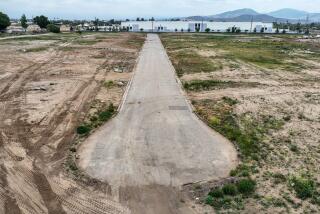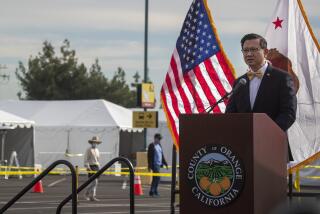Spending on El Toro Questioned
- Share via
Orange County may have improperly spent more than $800,000 in highly restricted John Wayne Airport funds to pay contractors at the former El Toro Marine base, documents show.
Two management firms were paid the money beginning in July, although it appears from county records that their airport-related tasks had ended and most of what they were entrusted to manage was a handful of recreation programs--a golf course, horse stables, an officers club, a child care center, a swimming pool and an RV storage lot.
County supervisors are expected to decide Tuesday whether to drop the recreation programs.
Earlier this month, supervisors unanimously voted to have a county auditor “scrub”--thoroughly review--an account set up to handle El Toro planning costs. Supervisor Todd Spitzer demanded the review after county and airport officials conceded that nearly $200,000 of John Wayne money had been improperly used since 1998 to pay JHTM Associates for reviewing El Toro planning work. The money had been paid through the company’s contract with John Wayne Airport.
Federal Aviation Administration officials would not comment directly on whether Orange County violated federal rules in its spending of John Wayne Airport dollars. The FAA has not reviewed Orange County’s use of airport funds since fall 1998 but would investigate any formal complaint, said Kirsti Dunn, an FAA spokeswoman in Seattle.
In recent years, federal officials have forced local government officials overseeing airports in Los Angeles, Florida, New York, Georgia and Texas to repay millions in airport money improperly used for such activities as airport-area golf courses, police and fire service, a sewage treatment plant, business parks and sponsorship of an international film festival.
Two former top federal officials said John Wayne Airport money channeled to the El Toro project should be used only for activities directly related to the planning and development of an airport. They said it would be improper if John Wayne money had been spent to help subsidize management of El Toro’s golf course, stables and former officers club.
“They are not supposed to use airport funds for that. If they’re doing that, then they are violating the law,” said Donald R. Segner, a former FAA associate administrator, who has questioned the use of John Wayne Airport dollars for El Toro planning for more than two years.
Mary Schiavo, former inspector general of the U.S. Department of Transportation, which includes the FAA, agreed.
“The short answer is no, it’s not allowed,” said Schiavo, who spent six years--1990 to 1996--investigating 43 airports across the country for improper expenditures.
Justifying airport spending by linking it to any activity at a base where there are plans for an airport is “too remote a link,” Schiavo said.
“Aviation money can only be spent [on activities] for moving passengers and property,” the former inspector general said.
Since 1994, county officials had been planning air cargo operations at the base, the first step toward creating an international airport.
Toward that end, the county hired Cabaco Inc., an Arizona-based management company, and Gary Simon, a Huntington Beach real estate manager, in 1998 for work at the base.
But, by last spring, federal officials had grounded the county’s plans for cargo flights or any other current aviation activity at El Toro. The county’s top cargo negotiator quit in June, saying flights “wouldn’t happen any time soon.”
Still, the county continued for 10 months--July to April--to use $834,617 in airport money limited by federal law to be used “directly and substantially related to the air transportation of passengers or property.”
Spending Was Proper, County CEO Maintains
A review of the county’s El Toro expense records by The Times shows that John Wayne Airport money helped cover $715,168 in administrative costs during that time for Cabaco’s 10-person management team; and $119,449 for Simon, including $42,000 in severance pay after Simon’s contract was terminated Jan. 10.
Orange County Executive Officer Jan Mittermeier said last week that John Wayne Airport money has not been misspent.
She and other county officials said that although the cargo effort was eventually abandoned, Cabaco and Simon still had duties related to aviation planning. They had to prepare for the transition from a military base to a revenue-generating airfield, by drafting a transition plan, and conducting building inspections and an inventory of base property.
“All of that supports the ultimate reuse of an airport,” said John Christensen, the county’s spokesman on El Toro planning.
Monthly reports filed by Cabaco show the company was nearly finished with its assigned aviation-related tasks--the base transition plan and inventory--before July, when Cabaco began overseeing the recreation programs.
Yet the company’s invoices show that an average of 74% of its management team costs in the eight months since July were charged to airport funds even though the aviation work was deemed all but finished.
A source familiar with the company’s work said managers spent less than 5% of their time after July working on overall aviation base planning tasks, and 70% of their time managing the recreation programs. The remaining 25% of time was spent on care-taking activities under a separate contract with the Navy, which still owns the land and pays the county to provide security, fire and maintenance services.
The county insists that no money was misspent.
“Any work related to the [recreation programs] was not charged to aviation funds,” Mittermeier said. “Those never get any airport funds.”
Because the county does not require that Cabaco or Simon submit invoices based on individual management tasks performed at the base, nor does the county show a breakdown of what tasks are paid from various funds, it is impossible to know exactly how aviation funds were spent. Overall, the county paid Cabaco $2.3 million from John Wayne Airport money for base transition tasks.
What Is and Isn’t Aviation-Oriented?
Cliff Wallace, Cabaco’s El Toro program manager, said that since July, about half of the company’s management time was spent preparing for a lease allowing the county to take over the entire base until the property is deeded to the county. Though the preparation of that lease is not directly an aviation matter, county officials argued that it supports the ultimate creation of an airport and can be paid from aviation funds.
Simon said he performed a mix of duties to plan for the transfer of the base but was not regularly required to bill for them separately.
For one month, October, Simon voluntarily provided a breakdown of his work to the county. That billing shows that long after aviation planning was halted, Simon logged 40% of that month’s work on aviation-related planning, 30% on the recreation programs and 30% on Navy-reimbursed duties.
However, his paycheck that month came entirely from John Wayne Airport money, documents show.
“The [county] program managers were responsible for the source of the funds,” said Simon, now a consultant on the Los Angeles International Airport expansion project.
Spitzer said last week that if the county’s internal auditor confirms that any airport funds were misspent, he will call for investigations by the FAA, the Department of Transportation and the U.S. Department of Justice.
“On its face, it has the appearance of impropriety,” Spitzer said.
After questions over the use of John Wayne money surfaced in 1998, the Orange County counsel’s office researched the matter. At the time, airport foes were concerned about the amount of money paid to lobbyists and public relations firms. Although the FAA has allowed such activities, other expenditures must tie in to the overall airport master plan, County Counsel Laurence M. Watson wrote on April 8, 1999.
“Portions of the master plan which are not strictly aviation-related may also be funded from John Wayne Airport revenues, as long as those non-aviation portions are an integral part of the overall airport master plan or are for the purpose of assuring aviation compatibility,” Watson wrote.
Watson said this week that it would be impossible, without knowing the nature of Cabaco’s and Simon’s work, to give an opinion on whether the airport payments violated federal rules.
“Generally, if it is not aviation activities, in furtherance of an ultimate aviation reuse, then it should be paid with other dollars,” Watson said.
(BEGIN TEXT OF INFOBOX / INFOGRAPHIC)
Questionable payments
Orange County used $834,617 in highly restricted John Wayne Airport funds to help cover management costs of two contractors at the former El Toro Marine base:
Cabaco Base Asset Management Team: A Sierra Vista, Ariz., management team hired to introduce cargo flights, complete an inventory of base assets, write a base transition plan and run the golf course, officer’s club, horse stables, RV storage lot, child care center and a swimming pool at the base: Paid $715,168 since July 1999.
Gary Simon (real estate team manager at the base, in charge of coordinating the base interim use/leasing plan, oversight of the recreation programs.) Paid $119,449 since July 1999, including a $42,000 severance package after his contract was terminated in January.
Other questionable expenses paid out of aviation funds:
Richard Thorman (Golf course consultant to design a process to hire a golf course developer) Paid $44,588.
H.L. Miller Construction (contractor for renovations, including partitions, paint and carpeting for second floor offices at the Hall of Administration): Paid $39,802.
Ron Yeo (architect who designed renovations to the second floor of the Hall of Administration in Santa Ana for the El Toro project team): Paid $9,019
Rosenow Spevacek Group (Hired to coordinate a plan to provide assistance to organizations that provide housing for the homeless, a requirement when federal agencies unload surplus property that has contained housing units, such as at El Toro): Paid $10,076
TOTAL: $103,485
What federal rules allow:
”...revenues generated by an airport that is the subject of federal assistance may not be expended for any purpose other than the capital and operating costs of:
(1) the airport;
(2) the local airport system; or
(3) any other local facility that is owned or operated by the person or entity that owns or operates the airport that is directly and substantially related to the air transportation of passengers or property.”
--Title 49, United States Code, section 47133(a)
Source: County of Orange, United States Code, Times research
More to Read
Sign up for Essential California
The most important California stories and recommendations in your inbox every morning.
You may occasionally receive promotional content from the Los Angeles Times.











